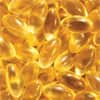
What's Hot
What's Hot
News flashes are posted here frequently to keep you up-to-date with the latest advances in health and longevity. We have an unparalleled track record of breaking stories about life extension advances.
Increased omega-3 fatty acid levels associated with reduction in hip fracture risk
 June 28, 2013. The March, 2013 issue of the Journal of Bone and Mineral Research published the results of a study conducted by researchers at Ohio State University which found a protective effect in postmenopausal women for elevated blood levels of omega-3 fatty acids against the risk of hip fracture.
June 28, 2013. The March, 2013 issue of the Journal of Bone and Mineral Research published the results of a study conducted by researchers at Ohio State University which found a protective effect in postmenopausal women for elevated blood levels of omega-3 fatty acids against the risk of hip fracture.
"Inflammation is associated with an increased risk of bone loss and fractures, and omega-3 fatty acids are believed to reduce inflammation," stated senior author Rebecca Jackson, who is a professor of endocrinology, diabetes and metabolism at Ohio State. "So we asked if we would see fractures decrease in response to omega-3 intake."
The study compared 324 women with a history of hip fracture who were enrolled in the Women's Health Initiative with an equal number of subjects without hip fracture matched for age, hormone use and race. Stored blood samples were analyzed for red blood cell omega-3 and omega-6 fatty acids.
Women whose total omega-3 fatty acid levels were among the top one-third of participants had a 45% lower risk of hip fracture in comparison with those whose levels were among the lowest third. For those whose levels of the omega-3 fatty acids alpha-linolenic acid (ALA) and eicosapentaenoic acid (EPA) were among the top third, the risk was 56% and 54% lower, and women whose omega-6 to omega-3 ratio was among the top third had almost double the risk.
"One thing that was critically important was that we didn't use self-report of food intake, because there can be errors with that," Dr Jackson noted. "We looked directly at the exposure of the bone cell to the fatty acids, which is at the red blood cell level. Red blood cell levels also give an indication of long-term exposure to these fatty acids, which we took into account in looking for a preventive effect."
—D Dye
Blood pressure, depression reduced by vitamin D supplementation in diabetic women
 June 26, 2013. A presentation at the American Diabetes Association 73rd Scientific Sessions held in Chicago revealed improvements in blood pressure and depression among diabetic women supplemented with a high dose of vitamin D. Depression is estimated to affect over 25% of diabetic women, and may impact their ability to manage their disease.
June 26, 2013. A presentation at the American Diabetes Association 73rd Scientific Sessions held in Chicago revealed improvements in blood pressure and depression among diabetic women supplemented with a high dose of vitamin D. Depression is estimated to affect over 25% of diabetic women, and may impact their ability to manage their disease.
In a pilot study conducted at Loyola University, Sue M. Penckofer, PhD, RN and her associates gave 46 diabetic women of an average age of 54.6 years 50,000 international units (IU) vitamin D weekly for six months. Participants had been diabetic for 7.8 years on average upon enrollment, and had insufficient serum levels of 25-hydroxyvitamin D. At the beginning and end of the study, depression was evaluated via the Center for Epidemiologic Studies Depression scale and Physicians Health Questionnaire, and weight, blood pressure and serum vitamin D levels were measured.
At the study's conclusion, the women's serum vitamin D levels had increased significantly, and depression, weight and blood pressure were reduced. Dr Penckofer plans to validate the study's findings in a placebo-controlled trial of 180 depressed diabetic women with vitamin D insufficiency funded by a four-year grant from the National Institute of Nursing.
"Vitamin D supplementation potentially is an easy and cost-effective therapy, with minimal side effects," stated Dr Penckofer, who is a professor at Loyola's Niehoff School of Nursing. "Larger, randomized controlled trials are needed to determine the impact of vitamin D supplementation on depression and major cardiovascular risk factors among women with type 2 diabetes."
—D Dye
Deficient vitamin D levels linked with adolescent allergy and asthma
 June 24, 2013. On June 18, 2013 at The Endocrine Society's 95th Annual Meeting in San Francisco, Candace Percival, MD of Walter Reed National Military Medical Center in Bethesda presented the findings of a role for vitamin D deficiency in allergies or asthma occurring in overweight adolescents. "The increased risk for asthma and allergies, and for more severe cases of allergic disease, in overweight and obese adolescents has not previously been understood," stated Dr Percival, who is a pediatric endocrinology fellow at Walter Reed. "However, past research has shown that vitamin D is important for a normal immune system and that vitamin D deficiency is common in obese individuals."
June 24, 2013. On June 18, 2013 at The Endocrine Society's 95th Annual Meeting in San Francisco, Candace Percival, MD of Walter Reed National Military Medical Center in Bethesda presented the findings of a role for vitamin D deficiency in allergies or asthma occurring in overweight adolescents. "The increased risk for asthma and allergies, and for more severe cases of allergic disease, in overweight and obese adolescents has not previously been understood," stated Dr Percival, who is a pediatric endocrinology fellow at Walter Reed. "However, past research has shown that vitamin D is important for a normal immune system and that vitamin D deficiency is common in obese individuals."
The investigation included 54 obese and 32 non-obese participants between the ages of 10 to 8 years. Blood samples were analyzed for 25-hydroxyvitamin D and other factors. Subgroups of participants were tested for adipokines (including leptin and adiponectin), immunoglobulin E, which is involved in allergic reactions, and cytokines (involved in immune response) that included interleukins 4, 6, 10 and 13, and interferon-gamma.
Higher body mass index (BMI) values were associated with increased plasma leptin levels and lower levels of adiponectin and vitamin D. In addition, body mass was positively correlated with higher levels of immunoglobulin E, and interleukins 6 and 13.
"This is the first study, to our knowledge, that ties together the relationship of vitamin D deficiency and increased allergy risk and severity in obese and overweight adolescents," Dr Percival announced.
"The relationship between the BMI-Z score and the adipokines and markers of allergic disease seemed to depend on the vitamin D deficiency seen in the more obese patients, leading us to conclude that the increased risk for allergy in obesity may be mediated by vitamin D to some degree," she concluded.
—D Dye
Cinnamon compounds may protect against tau protein aggregation in Alzheimer's disease
 June 21, 2013. The June, 2013 issue of the Journal of Alzheimer's Disease published an article by Donald J. Graves and his associates at the University of California, Santa Barbara which describes how compounds in cinnamon reduce the aggregation of tau protein that occurs, along with amyloid-beta aggregation, in the brains of men and women with Alzheimer's disease.
June 21, 2013. The June, 2013 issue of the Journal of Alzheimer's Disease published an article by Donald J. Graves and his associates at the University of California, Santa Barbara which describes how compounds in cinnamon reduce the aggregation of tau protein that occurs, along with amyloid-beta aggregation, in the brains of men and women with Alzheimer's disease.
Tau protein is responsible for the assembly of microtubules within the cell that form its structure. When tau does not effectively bind to the microtubules, it clumps together, forming tangled fibers. Previous research conducted by Dr Graves' team uncovered an ability of cinnamon extract to inhibit tau aggregation and dissociate tangles in brain tissue derived from Alzheimer's disease patients.
The current study revealed that the compounds cinnamaldehyde and the oxidized form of epicatechin derived from cinnamon extract inhibited tau aggregation in vitro by protecting the protein from oxidative stress. "Take, for example, sunburn, a form of oxidative damage," explained Dr Graves, who is an adjunct professor at the UC Santa Barbara's Department of Molecular, Cellular, and Developmental Biology. "If you wore a hat, you could protect your face and head from the oxidation. In a sense this cinnamaldehyde is like a cap."
"Since tau is vulnerable to oxidative stress, this study then asks whether Alzheimer's disease could benefit from cinnamon, especially looking at the potential of small compounds," added lead author Roshni C. George. "Cell membranes that are oxidized also produce reactive derivatives, such as Acrolein, that can damage the cysteines. Epicatechin also sequesters those byproducts."
"Wouldn't it be interesting if a small molecule from a spice could help?" Dr Graves asked. However, he cautioned that they are "still a long way from knowing whether this will work in human beings."
—D Dye
Life-extending mechanism of Rhodiola explored
 June 19, 2013. The journal PLOS ONE published an article online on May 21, 2013 which reports a benefit for Rhodiola rosea in extending the life span of fruit flies when administered orally. The herb does not appear to promote longevity via mechanisms involved in calorie restriction, which is a well known method of extending life span in experimental models.
June 19, 2013. The journal PLOS ONE published an article online on May 21, 2013 which reports a benefit for Rhodiola rosea in extending the life span of fruit flies when administered orally. The herb does not appear to promote longevity via mechanisms involved in calorie restriction, which is a well known method of extending life span in experimental models.
Previous studies revealed that Rhodiola can extend the lives of flies, worms and yeast. In order to determine whether Rhodiola utilized the same mechanisms as calorie restriction, Mahtab Jafari and colleagues at the University of California, Irvine gave Rhodiola to fruit flies provided with diets containing reduced amounts of yeast. If Rhodiola extended lifespan in a manner similar to that of dietary restriction, it was not expected to be associated with longer life in animals in which the molecular pathways associated with dietary restriction were already affected, however, Dr Jafari's team observed an increase in mean and maximum life span in male and female flies that received Rhodiola. "We found that Rhodiola actually increases lifespan on top of that of dietary restriction," he stated. "It demonstrates that Rhodiola can act even in individuals who are already long-lived and healthy."
In fruit flies in which the known molecular pathways associated with calorie restriction (including silent information regulator 2 (SIR2) proteins, insulin and insulin-like growth factor signaling and target of rapamycin pathways) were perturbed, Rhodiola still elicited an extension of life span.
"Of particular note is our finding that R. rosea feeding when combined with a low dietary yeast content (0.3%) resulted in some of the longest lived laboratory flies, with mean lifespans of over 90 days and maximum lifespans exceeding 120 days in both sexes," the authors wrote. "Thus, the extract has the potential to improve longevity in humans of both genders who are healthy and non-obese."
Photo courtesy of Wikimedia Commons.
—D Dye
Preventing vitamin D deficiency may help delay early puberty
 June 17, 2013. A presentation on June 17, 2013 at The Endocrine Society's 95th Annual Meeting held in San Francisco revealed a greater risk of precocious puberty in girls with deficient levels of vitamin D in comparison with girls who entered puberty at a normal age. Early puberty in girls is defined as the onset of sexual development before the age of 8. The incidence of precocious puberty has increased over the past several decades, and girls affected by the condition may have a higher risk of breast cancer or other conditions later in life.
June 17, 2013. A presentation on June 17, 2013 at The Endocrine Society's 95th Annual Meeting held in San Francisco revealed a greater risk of precocious puberty in girls with deficient levels of vitamin D in comparison with girls who entered puberty at a normal age. Early puberty in girls is defined as the onset of sexual development before the age of 8. The incidence of precocious puberty has increased over the past several decades, and girls affected by the condition may have a higher risk of breast cancer or other conditions later in life.
The current research, led by Min Sun Kim, MD, PhD who is an assistant professor at Chonbuk National University Medical School in Jeonju, South Korea, included 110 girls aged 7 to 10 years, among whom 35 were categorized as having experienced precocious puberty according to the Tanner Scale. Blood samples collected from the subjects were analyzed for serum 25-hydroxyvitamin D levels and other factors.
Vitamin D levels were lower on average among girls with early puberty in comparison with girls who entered puberty at a normal age. Forty-four percent of the girls who underwent precocious puberty had serum 25-hydroxyvitamin D levels were classified as severely deficient at less than 10 nanograms per milliliter (ng/mL) in comparison with 21% of the normal group. In additional experimentation, the researchers found that the administration of vitamin D suppressed the ability of N-methyl-D-aspartate (NMDA) to release gonadotropin-releasing hormone (GnRH, which triggers the ovulation process) from neurons.
"If we understand more about the action mechanism of vitamin D on GnRH neuronal activities, we can find a clue to control of precocious puberty using vitamin D or related molecules," Dr Kim explained. "Our results suggest that vitamin D may inhibit early pubertal onset and/or the rapid progression of puberty, at least in part, through the suppression of NMDA-mediated GnRH neuronal excitation in humans."
—D Dye
Decreased DHEA sulfate levels linked to greater stroke risk in women
 June 14, 2013. In the American Heart Association journal Stroke, researchers from Brigham and Women's Hospital and Harvard School of Public Health report an association between lower levels of the hormone dehydroepiandrosterone sulfate (DHEAS) and a greater risk of stroke in older women. Their findings appeared online in the journal on May 23, 2013.
June 14, 2013. In the American Heart Association journal Stroke, researchers from Brigham and Women's Hospital and Harvard School of Public Health report an association between lower levels of the hormone dehydroepiandrosterone sulfate (DHEAS) and a greater risk of stroke in older women. Their findings appeared online in the journal on May 23, 2013.
The study included women who had no history of stroke upon enrollment in the Nurses' Health Study in 1976. Stored blood samples obtained between 1989 and 1990 were analyzed for DHEA sulfate levels. Four hundred sixty-one participants in whom stroke had occurred over follow-up were matched for age, race, menopausal status and other factors with an equal number of control subjects.
Women who experienced a stroke were likelier to be diabetic and have a history of high blood pressure in comparison with the control group. Among women whose DHEAS levels were among the lowest 25% of participants in the current study, the adjusted risk of experiencing an ischemic stroke was 33% higher than that of women whose levels were among the top 25%. Further adjustment of the analysis increased the percentage to 41%.
Authors Kathryn M. Rexrode MD, MPH and colleagues note that DHEA could influence the development of cardiovascular disease and stroke through mechanisms that include inhibition of the migration and proliferation of vascular wall cells, and stimulation of vascular smooth muscle cell apoptosis, which reduces vascular remodeling subsequent to injury.
"To our knowledge, this is the first report to evaluate DHEAS levels and risk of ischemic stroke," the authors announce. "In this cohort of older women, these results suggest evidence for an inverse association between DHEAS and risk of ischemic stroke, where lower levels of DHEAS were associated with an increased risk of ischemic stroke."
"Additional research is warranted to confirm these associations in other populations," they conclude.
—D Dye
Higher dose metformin associated with improved survival among colorectal cancer patients
 June 12, 2013. The journal Cancer Epidemiology, Biomarkers & Prevention published an article on June 10, 2013 which reports a benefit for the antidiabetic drug metformin in colorectal cancer survival.
June 12, 2013. The journal Cancer Epidemiology, Biomarkers & Prevention published an article on June 10, 2013 which reports a benefit for the antidiabetic drug metformin in colorectal cancer survival.
The study involved 3,816 men and women with stage I-III colorectal cancer diagnosed between 2001 and 2006, including 207 diabetics who had been prescribed metformin, 108 diabetics who did not use the drug and 3,501 nondiabetics. The subjects were followed through 2010, during which 196 deaths occurred among those with diabetes and 1,897 occurred among the nondiabetics. Among the diabetic patients, 93 deaths were due to colorectal cancer, and 1,082 nondiabetic deaths were attributable to the disease.
When subjects treated with metformin were compared to diabetics who did not use the drug, a reduction in the risk of death due to colorectal cancer that "approached significance" was observed. However, those whose use of metformin was categorized as high intensity (higher dose), had a 56% lower risk of dying of the disease than diabetics who did not use the drug. Metformin use was additionally associated with a 31% lower adjusted risk of dying from any cause among diabetic subjects over follow-up.
"This study is the first, to the authors' knowledge, to assess the presence of an exposure response effect between increasing metformin use and colorectal cancer outcomes," authors Susan C. Spillane and her colleagues at St James Hospital in Dublin announce. "Significant associations were observed in stratified analyses of high intensity exclusive metformin usage and the results also suggest that metformin exposure may potentially improve survival relative to non-diabetic patients. Additional studies in larger population-based cohorts are required to further explore the influence of varying exposure levels and timing and to determine if any patient subgroups are more likely to benefit from metformin."
—D Dye
Increased vegetable fat intake linked with lower risk of premature death in prostate cancer patients
 June 10, 2013. In an article published online on June 10, 2013 in JAMA Internal Medicine, researchers from the University of California and Harvard report an association between greater consumption of vegetable fat intake and a lower risk dying over an 8.4 year median among men with prostate cancer.
June 10, 2013. In an article published online on June 10, 2013 in JAMA Internal Medicine, researchers from the University of California and Harvard report an association between greater consumption of vegetable fat intake and a lower risk dying over an 8.4 year median among men with prostate cancer.
The current investigation included 4,577 men enrolled in the Health Professionals Follow-Up Study who were diagnosed with nonmetastatic prostate cancer between 1986 and 2010. Dietary questionnaires completed at the beginning of the study and every four years thereafter provided data on fat intake.
Over a median period of 8.4 years, there were 1,064 deaths. Events of lethal prostate cancer, defined as the occurrence of distant metastases or death from the disease, occurred in 315 subjects. The adjusted risk of events of lethal prostate cancer was 16% higher among those whose animal fat intake was among the top 20% in comparison with those whose intake was among the lowest 20%. In contrast, having an intake of vegetable fat that was among the top 20% was associated with a 35% lower risk.
When death from any cause was examined, those whose animal fat intake was highest had a 19% greater risk of dying over follow-up in comparison with the lowest group, and those whose vegetable fat intake was highest had a 35% lower risk. Replacement of 10% of calories from carbohydrates with vegetable fat was associated with a 26% lower risk of mortality from any cause over the follow-up period.
"Overall, our findings support counseling men with prostate cancer to follow a heart-healthy diet in which carbohydrate calories are replaced with unsaturated oils and nuts to reduce the risk of all-cause mortality," Erin L. Richman and her colleagues write. "The potential benefit of vegetable fat consumption for prostate cancer-specific outcomes merits further research."
—D Dye
Reduced vitamin D levels linked with increased hepatitis B viral replication
 June 7, 2013. The journal Hepatology published an article on May 22, 2013 which revealed an association between reduced vitamin D levels and increased replication of the hepatitis B virus (HBV).
June 7, 2013. The journal Hepatology published an article on May 22, 2013 which revealed an association between reduced vitamin D levels and increased replication of the hepatitis B virus (HBV).
"Vitamin D helps maintain a healthy immune system and there is evidence of its role in inflammatory and metabolic liver disease, including infection with hepatitis C virus (HCV)," noted lead researcher Christian M. Lange of Johann Wolfgang Goethe University Hospital in Frankfurt, Germany. "However, the relationship between vitamin D metabolism and chronic HBV infection remains unknown and is the focus of our present study."
Dr Lange and his colleagues measured serum 25-hydroxyvitamin D levels in 203 chronic hepatitis B patients who had not yet initiated therapy. Vitamin D deficiency, defined as serum levels of less than 10 nanograms per milliliter (ng/mL) were detected in 34% of the patients and insufficient levels, ranging between 10 and 20 ng/mL, were uncovered in 47%.
Among those with serum hepatitis B DNA concentrations of less than 2,000 international units per milliliter, vitamin D levels averaged 17 ng/mL in comparison with an average of 11 ng/mL among participants with higher viral loads. Additionally, subjects who were positive for hepatitis B early antigen (HbeAg) had lower levels of the vitamin than those who were HBeAg negative. Furthermore, the researchers observed seasonal fluctuations in both serum hepatitis B DNA and vitamin D, with higher levels of one associated with lower levels of the other.
"Our data confirm an association between low levels of vitamin D and high concentrations of HBV in the blood," Dr Lange concluded. He suggests additional research involving the administration of vitamin D as a possible means of controlling hepatitis B infection.
—D Dye
Folic acid supplementation reduces colorectal adenoma risk
 June 5, 2013. An article appearing in the July 2013 issue of Cancer Prevention Research reports the outcome of a trial conducted in China which found a 50% average reduction in the risk of sporadic colorectal adenomas in older men and women supplemented with folic acid. Colorectal adenomas (polyps), while often benign, can be a precursor to colorectal cancer, with 90% of cases starting as adenomas.
June 5, 2013. An article appearing in the July 2013 issue of Cancer Prevention Research reports the outcome of a trial conducted in China which found a 50% average reduction in the risk of sporadic colorectal adenomas in older men and women supplemented with folic acid. Colorectal adenomas (polyps), while often benign, can be a precursor to colorectal cancer, with 90% of cases starting as adenomas.
Researchers at Shanghai Jiao-Tong University School of Medicine randomized 791 subjects between the ages of 50 and 80 years with no adenomas to receive 1 milligram (mg) folic acid per day or a supplement without folate for three years. Plasma folate levels were measured upon enrollment and at the end of the treatment period. Colonoscopies administered at the study's conclusion ascertained the location and size of all polyps, which were subsequently examined by a pathologist.
Colorectal adenomas were found in 30.7% of participants who received a placebo and 14.9% of the folic acid group. There was also a reduction in the risk of advanced adenomas among those who received folic acid. A greater risk of adenoma was observed among subjects in either group whose plasma folate levels were lower at the beginning of the study.
"Although several studies have suggested that high-dose folic acid might increase the recurrence and progression of colorectal cancer, only two participants in our folic acid group developed colorectal cancer during three years of follow-up and there was no significant difference with the control group," the authors write. "We believe that 1 mg/day folic acid supplementation is safe and has few side effects."
"Those with low plasma folate should be encouraged to take adequate supplements, and plasma folate should be elevated to an effective therapeutic level, which may reduce the incidence of colorectal adenoma," they conclude.
—D Dye
Four gives you more
 June 3, 2013. An article published online on June 3, 2013 in the American Journal of Epidemiology reveals that the practice of just four healthy lifestyle factors by men and women without cardiovascular disease reduced the risk of dying by 80 percent over a 7.6 year period in comparison with those who followed none of the practices.
June 3, 2013. An article published online on June 3, 2013 in the American Journal of Epidemiology reveals that the practice of just four healthy lifestyle factors by men and women without cardiovascular disease reduced the risk of dying by 80 percent over a 7.6 year period in comparison with those who followed none of the practices.
The current analysis included participants in the Multi-Ethnic Study of Atherosclerosis (MESA), an ongoing study of the risk factors, prevalence and prevention of cardiovascular disease. Participants underwent coronary artery calcium screening upon enrollment to ascertain the presence of calcium deposits, which predict heart attack risk. Subjects were scored on their adherence to behaviors that included not smoking, engaging in regular exercise, consuming a Mediterranean style diet and maintaining a normal weight, and were followed for an average of 7.6 years during which any chest pain, coronary events, or deaths were noted.
"We evaluated data on more than 6,200 men and women, age 44-84, from white, African-American, Hispanic and Chinese backgrounds," reported lead author Haitham Ahmed, MD, MPH, who is an internal medicine resident with the Johns Hopkins Ciccarone Center for the Prevention of Heart Disease. "All were followed for an average of 7.6 years. Those who adopted all four healthy behaviors had an 80 percent lower death rate over that time period compared to participants with none of the healthy behaviors."
"To our knowledge, this is the first study to find a protective association between low-risk lifestyle factors and early signs of vascular disease, coronary heart disease and death, in a single longitudinal evaluation," he announced. "While there are risk factors that people can't control, such as their family history and age, these lifestyle measures are things that people can change and consequently make a big difference in their health. That's why we think this is so important."
—D Dye

